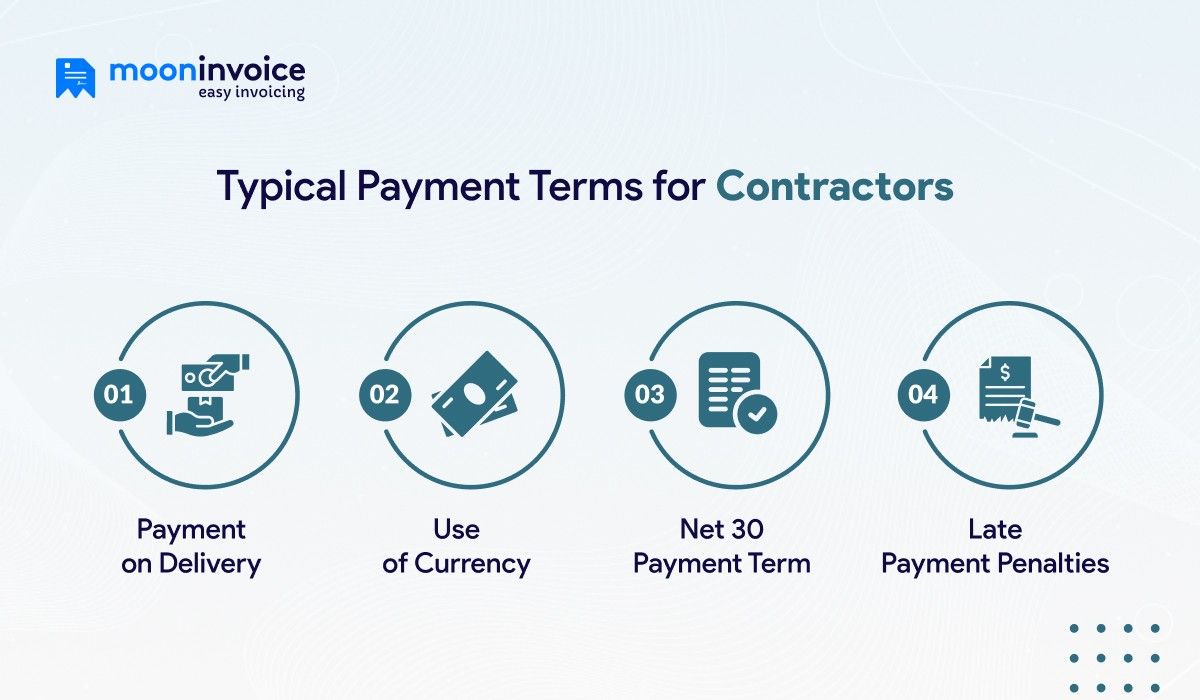In the construction industry, an independent contractor payment schedule plays a central role in bringing your project to life. But many contractors don’t get paid for their services, mainly because of unclear or missing payment terms.
In this blog, we will explain to you what are common payment terms for contractors and why to include them.
What are Contractor Payment Terms?
Payment terms refer to the conditions governing how and when contractors should get paid for their services. Often included in an invoice or estimate, they clarify the accepted payment methods and underscore any special requirements discussed during a meeting with the client.
Failing to meet the payment terms mentioned in an invoice will invite late penalties for the recipient. Therefore, contractors include clear payment terms when generating a new invoice to ensure timely payment.
Typical Payment Terms for Contractors

Here are some of the standard payment terms utilized by contractors when generating an invoice or estimate.
1. Payment on Delivery
Construction Contractors often ask clients to complete payment once they have finished the task. So, contractors neither have to wait longer for payments nor annoy clients by making frequent phone calls.
With this payment term, the client is responsible for making an instant payment immediately after the contractor completes their job. Sometimes, contractors also outline the same payment terms in an estimate to inform the client about payment urgency.
2. Use of Currency
The mention of accepted currency by the contractor is another standard payment term. With this, contractors aim to keep their foreign clients informed and reduce the time it takes for fund transfers. Such payment terms also help clients choose the ideal payment method, which usually has low transaction fees.
Clarifying this payment condition prior to the payment process can save time for both parties. The client doesn’t incur additional charges for transferring money twice, while the contractor receives the funds on time.
3. Net 30 Payment Term
Net 30 is a standard payment term that allows clients 30 days to clear the payment. Contractors use a net 30 payment term on an invoice to provide payment flexibility and strengthen their relationship with the client.
Noticing a net 30 payment term, the client will understand that they have 30 days to pay the outstanding amount, starting from the day the invoice is issued.
4. Late Payment Penalties
Describing late fees upon payment delays is also a common practice. Contractors use this term to inform clients how much more money they need to pay if they fail to make a payment on time. Contractors mentioning late payment terms not only boost payment but also set them free from having to chase payments.
Such payment terms are used to encourage clients to make timely payments, so that contractors can collect the money without needing follow-up emails.
Kick the Stressful Invoicing’s Butt
Whether you are a newbie or a pro, our AI-powered invoicing software can help you with 2-min invoicing, minus the stress.
Why Include Payment Terms in Construction Contracts?
Below are the factors that explain why writing payment terms in construction contracts should be a common practice for invoicing.
1. Timely Payments
Specifying the payment terms can make sure the client follows the contractor’s payment schedule. This is because when the client learns about late penalties, they might process payments as early as possible, before the due date. Payment terms could be your only solution to combat late payments for construction payment schedules.
2. Legal Protection
Payment terms listed on an invoice help you avoid legal consequences if a client files a lawsuit against your construction company. Since an invoice is a legally binding document, you can settle legal cases if you have properly mentioned payment terms and conditions in an invoice.
3. No Communication Gaps
The presence of contractor payment terms on an invoice leaves no room for communication gaps. Both the issuer and the recipient would be on the same page. The issuer will know when to expect the payment, while the recipient will realize how quickly they need to complete the payment.
Who Sets Contractor Payment Terms in the US?
Payment terms for contractors are set by mutual agreement between the contractor and the owner of the project. Many contractors would have their own payment terms, which can be negotiated as per the project owner’s convenience and some other factors.
Furthermore, payment terms are also likely to be influenced by local regulations like the Prompt Payment Act. But, only in exceptional cases, and not all the time. Hence, it’s more like contractors themselves setting payment terms in the US.
Independent Contractor Payment Schedule
Below are examples of contractor payment terms to check out.
1. Cash on Delivery (COD)
COD is a pretty straightforward payment term. It is the contractor’s way of saying, “Hey, I delivered the service, so you owe me money”. As soon as the contractor’s work is done, the client needs to initiate the payment online or hand over the cash. Failing to pay dues according to the payment schedule may result in fines.
For example, a contractor is hired to repair a pipe leak at a local restaurant. Upon completing the work, the contractor sends an invoice with a COD (cash on delivery) payment term to the client. Now, the hiring party needs to pay the contractor after assessing their work.
2. Net 30, 60, & 90 Payment Terms
While some contractors can schedule their payments using short payment terms, such as net 7, 15, or 30 days, others prefer longer payment terms, like net 30, net 60, or net 90 days. Short payment terms provide extra days to fulfill the payment. Whereas, long payment terms offer a month or even more time to pay the outstanding amount.
Let’s say the flooring contractor is hired to repair wood flooring. Soon after completing the flooring job, the contractor creates an invoice using flooring invoice template with net 30 payment terms. Once invoice is dispatched, it means that the client can pay the due amount within 30 days to avoid any additional fees.
3. 2/10 Net 30 Payment Term
If a contractor uses 2/10 net 30 or 1/10 net 30 payment terms, it provides a rewarding opportunity for the client. In simpler terms, the client can earn a 2% or 1% discount on the total amount if they complete the payment within the first 10 days from the invoice issue date.
In such cases, payment is scheduled to be made within 30 days, but contractors may receive it early due to the discounts that 2/10 net 30 terms bring.
For instance, if the client assigns a landscaping job to a local contractor, the contractor may complete the work and send an invoice with terms such as “net 2/10” or “net 30”. Now, the client can pay the money within 10 days and earn a 2% discount on the total amount due. Following the 10 days, the full amount needs to be paid before the due date.
4. End of Month
As its name suggests, end-of-month payments are scheduled for collection at the end of the current month, regardless of when the work was completed. Contractors include the end-of-month payment term so the client can understand that they need to fulfill their dues before the end of the month.
For example, if the client receives an invoice on April 11th, the payment is scheduled to be completed before the end of the month, i.e., before April 30th. That’s how contractors get paid in the same month.
What are the Methods to Keep Clients Within Payment Schedules?
Want to encourage clients to pay invoices as per the agreed payment schedule? Here are some actionable tips.
1. Introduce Penalties
Start collecting penalties from late-paying clients in a bid to boost your collection efforts. You can charge 1-2% of the total invoice as a penalty if the dues are not paid within the given timeline. The move will surely make a difference, as nobody will be ready to pay extra money. Ultimately, you will receive invoice payments on time, so that there are no cash flow issues.
2. Go for Early Discounts
Create invoices with discount payment terms such as 1/10 Net 30 or 2/10 net 30 to draw payments from clients early. This is a simple yet effective way to inspire clients to make timely payments with a discounted price on their total invoice amount. So, it’s better to use discount payment terms rather than keep reminding clients about payments.
3. Accept Cashless Payments
Collect cashless payments using eWallets or bank transfers instead of traditional checks or cash payments. Some clients may not have time to hand over cash, and therefore, it makes sense to collect cashless payments from them. You can make digital invoices, along with a payment link or other client-preferred payment method.
Creating an Invoice with Payment Terms [Contractor’s Checklist]
Creating an invoice isn’t just about listing what you’re owed—it’s also about setting the right expectations for how and when you want to get paid. Here’s the checklist to follow when creating an invoice on software like Moon Invoice.
1. Include Basic Invoice Details
Make sure the basics are in place so there’s no confusion:
- Your business name, address, and contact information
- Client’s name and contact details
- Unique invoice number
- Invoice date and due date
- Description of services provided
- Total amount due
2. Add Payment Terms
This is key. Spell out exactly how and when you expect to be paid. Examples:
- Net 30 (payment due within 30 days)
- COD (Cash on Delivery)
- 2/10 Net 30 (2% discount if paid within 10 days)
3. Attach Online Payment Methods
List the payment options you are okay with:
- Bank transfer
- Credit/debit card
- PayPal, Stripe, etc.
- Checks or cash (if applicable)
If you work with international clients, mention the accepted currency to avoid back-and-forth later.
4. Include a Payment Due Date
Even if you’ve used a term like “Net 30,” adding an actual date (like “Due by May 15, 2025”) helps avoid misunderstandings. With Moon Invoice, you can automatically add a due date after adding a specific payment term.
5. Include Special Instructions
This is optional but helpful for things like:
- Project references
- Warranty or service follow-ups
Friendly thank-you message to build rapport
6. Review & Save
Before sending the invoice:
- Make sure all numbers add up
- Confirm that client details are accurate
Review the construction contract payment terms for clarity.
Invoicing Isn’t Something You Need to Sweat Over
Let Moon Invoice take invoicing off your hands and help you focus on fueling your business growth.
Takeaways
Whether you are a contractor or a freelancer, payment delays are common for many. Encompassing payment terms may clarify how and when the payment should be made, but don’t always guarantee timely payment.
Either keep following up even after mentioning payment terms, or switch to a powerful invoicing software like Moon Invoice if you want to get paid faster. The latter is more effective, as it comes with advanced invoicing features that help prevent payment delays and enhance customer satisfaction.
Avail Moon Invoice’s free trial for a limited time and experience seamless invoicing.



















